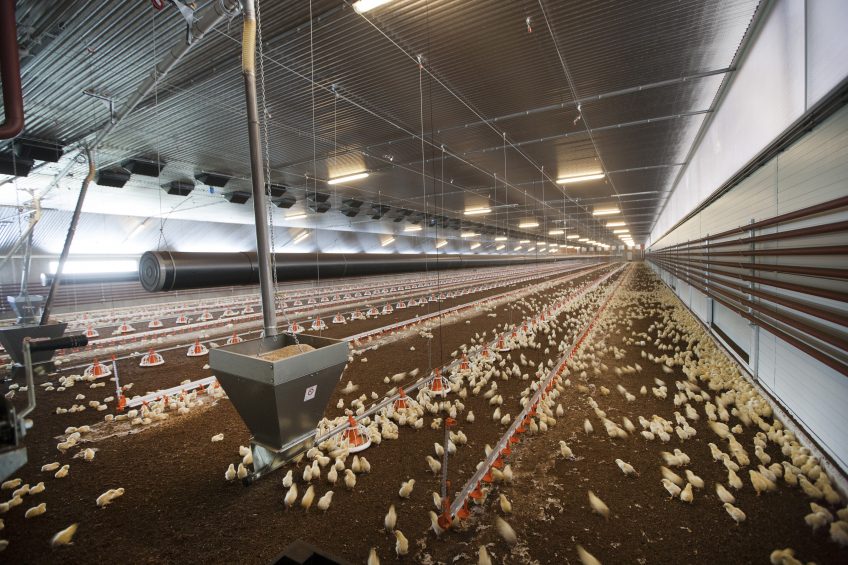‘Better Life’ standard a healthy choice

Broiler farmers Tienus and Alie Berkepies switched from regular broiler production to Better Life standard (‘Beter Leven’ – 1 star) at the beginning of 2017. They recently built their third poultry house and now have 75,000 chicks on 8,000 square metres. The new poultry house is equipped with ceiling ventilation.
“I like to work, but it takes up so much of your free time,” says Tienus Berkepies with a wink. The passionate entrepreneur has invested heavily in his business in the past years. He cleverly used opportunities for subsidies. There are 1,850 solar panels on his farm buildings, which annually yield 500,000 kilowatt hours. Berkepies replaced his wood burning boiler from 2006 with a brand new one in 2016. By doing so, he benefited from an energy saving subsidy. “I am not afraid to invest, but I do want to see returns. The return on investment is leading,” says Berkepies.
Electrical pump on solar energy
Berkepies is also an arable farmer. His fields were suffering from drought this summer. Berkepies therefore watered 60 hectares, a little bit over half of his land. He used an electrical pump and water from his own well. The pump has a capacity of 65 cubic metres of water an hour and a water pressure of 16 bar. “Because of the solar panels on my poultry houses, I could water my land for free during the day,” Berkepies says. The pump cost him € 20,000. This investment has long since been recouped. “Our farm is situated on dry sandy soil, so we have to water our lands every summer. We save over € 200 per day on diesel oil.”
‘Better Life’ production
The summer was characterised by drought and high temperatures which is unusual for the Netherlands, but Berkepies did not need to worry about the well-being of his broilers. The animals did not suffer from heat stress at all. The entrepreneur chose to produce according to the ‘Better Life’ – 1 star programme of the Dutch Animal Protection Foundation in the autumn of 2016 and switched completely at the beginning of 2017. With 9,5 broilers per square metre and a maximum of 25 kilogrammes of meat per square metre at the end of the flock, the occupation of space in the poultry house has decreased significantly. “In the past years, with regular broiler production, we had to really pay attention to these weather conditions, especially in the second half of the flock,” says Berkepies, who found thousands of dead broilers in his poultry house over five years ago. “In those years, tropical temperatures really stressed me out. I do not miss that tension at all now.” At the same time, he does miss the top sport model. With the slow growing chicks, he does not need to sail as close to the wind as he used to. “It is a lot easier now, but I do miss the challenge. I now have to make sure the chicks do not go past 2,500 grammes.”
Profile: Tienus (52) and Alie (49) Berkepies

The Berkepies family has 75,000 broilers on 8,000 square metres (Better Life – 1 star). They have three poultry houses. Their arable land covers 110 hectares.
The building plan largely consists of seed potatoes (70 hectares), supplemented with ware potatoes, sugar beets and grain. Berkepies trades a lot with livestock breeders. He bought his brother’s dairy farm. He also lets the buildings.
In consultation with the processor, Berkepies switched to the Better Life standard. The starting point: earn just as much, but with less work. “The market for concept meat production was growing and demand increased,” says Berkepies. “The broiler farmer switched from a 6,5 week planning to 9 week planning. The number of broilers decreased significantly. Before, he kept 84,000 chicks on 4,200 square metres. Now he has 75,000 chicks on 8,000 square metres. “The market is reasonably monitored. But if demand deteriorates and the market saturates, I will switch back.” Berkepies closely monitors the bottom line.

Neatly finished
With the switch to Better Life, much has changed on the farm. A covered range was built next to both existing poultry houses. Skylights were placed in the roofs. The construction of the new poultry house (95 x 28 m) was the final piece of the modernisation of the Berkepies family’s broiler branch. Berkepies initially wanted to build a so-called Sunbro poultry house, according to the concept of fellow broiler farmer Paul Grefte. However, this type of poultry house did not fit in the construction plan. The alternative is just as good. Berkepies is proud of the new building. “Building firm Van Pijkeren built a beautiful poultry house. It is as neatly finished as a residential home.”
Additional costs of € 100.000
Berkepies estimates that the additional costs add up to € 100.000, partly due to the choice for the ventilation attic. The basic building costs amount to € 20 per broiler, based on 28,000 animals. Each broiler place costs € 32, including equipment. “This poultry house needs to last many years,” adds Berkepies. “With ceiling ventilation, you can combat ventilation problems.” The fresh air enters the poultry house through the striking front. The inlet air is automatically conditioned in the air duct and is additionally heated by the indoor Plettenburg heat exchanger, situated in the attic. In the first weeks of the round, the heat exchanger takes care of the minimum ventilation.

The heated inlet air reaches the broilers through two low hanging pipes. Berkepies chose ceiling ventilation, which is not a standard choice for broiler farmers. “Because of the ceiling ventilation, I can ventilate under equal pressure and get as much air in as I blow out. I want to prevent the influence of a draught through the outlet valves. A comfortable and healthy climate, that is what you need with chicks at low stocking density.”












